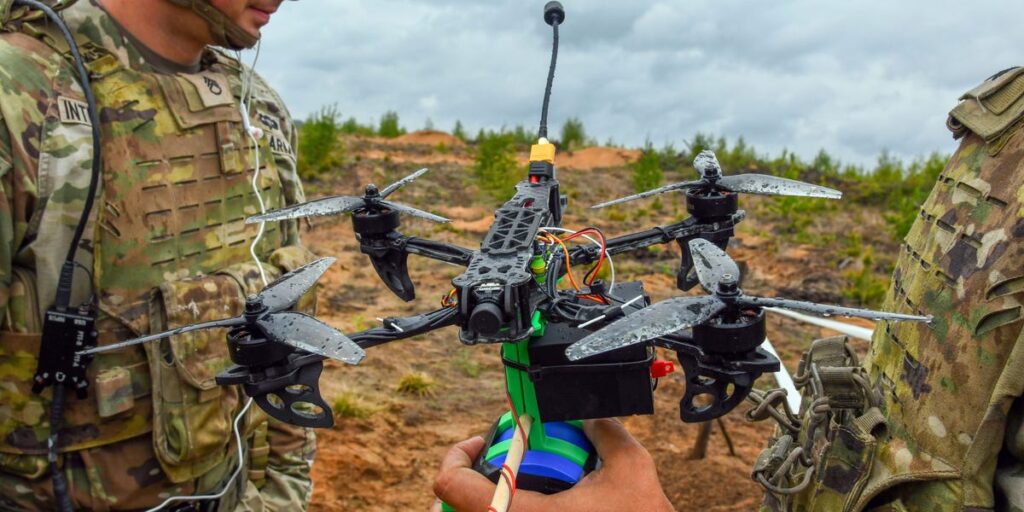US Army soldiers are tearing apart drones, printing out new parts, and flying their own creations into live-fire drills — a crash-course in the messy, fast-paced world of drone warfare.
The Army has launched a sweeping push to weave drones into combat across the force. For now, that work can look improvised and experimental, with soldiers moving quickly and sharing feedback as they go.
In line with the Army’s significant transformation initiative, over the past nine months, the Bayonet Innovation Team of the 173rd Airborne Brigade, part of the Army’s Southern European Task Force, Africa, has been building, flying, and reconfiguring drones. In exercises in Lithuania, Tunisia, and Germany, the brigade used first-person view drones to strike static and moving targets, 3D-printed parts to test new designs, and artificial intelligence-enabled software to refine tactics.
All of this hard work culminated in the 173rd successfully achieving the Army’s first drone-on-drone kill earlier this month during a summit at Fort Rucker, Alabama. The data gathered from that milestone — and at every step leading up to it — has been considered and shared.
The 173rd’s 1st. Lt. Francesco La Torre, who was the officer in charge during the Army’s first air-to-air kill with a first-person-view drone, told Business Insider that “there’s an incredibly open and approachable atmosphere to innovation when it comes to small UAS and then also all forms of unmanned systems.”
La Torre described the feedback from testing drones as “incredibly actionable,” noting that it spreads quickly between units and doctrines across the Army. Lessons learned from one system or tactical environment are quickly communicated and implemented, and it’s open across program offices, adjacent units, and commanders.
“Now more than ever before, information is being shared between so many organizations and so many stakeholders in lethality and readiness that it’s improving other programs and systems,” La Torre said.
Over the past year or so, the integration of those systems has been quick and extensive.
Trainings and exercises have adapted and ultimately been made more realistic. The Army’s AI tools, like Palantir’s Gotham and Maven Smart System, the latter being the Pentagon’s main AI platform, as well as Foundry, have made data sharing and integration easier.
In one instance, the 173rd Airborne was able to use AI on a long-range reconnaissance drone that could recognize targets to speed up decision-making. In another, terminal guidance systems helped ensure FPV drones reached their targets, especially in the last meters when a pilot closes in.
For paratroopers like those in the 173rd specifically, how drones fit into the mission set is a bit different from the rest of the Army. Paratroopers have a more expeditionary mission than some other units, needing to be able to survive behind enemy lines for extended periods of time. That reality could mean fighting and surviving in highly contested environments for several days at a time.
Thus, the requirements for the drones used by paratroopers might look a bit different, La Torre said. “I’m looking for one, something that can jump with me out of an aircraft, and then two, I’m looking for a system that I can fight with for days at a time.”
Lower-cost systems, and ones that can carry munitions and other payloads, can conduct a variety of operations for paratroopers. And if a drone works within the constraints of a paratrooper’s requirements, then it will likely work for the rest of the Army and broader American force, he added.
The Army considers drones, UAS capabilities, and counter-drone technologies critical for preparing for potential future conflict. Leadership is flooding units across the service with these weapons, and in turn, individual soldiers are working out the kinks in real time.
Some US soldiers are learning how to fly drones in the humid, rainy climates of the Indo-Pacific, adjusting as a system loses battery power or can’t take off as expected. Others in Europe have found that the way they carry drones on their rucksacks — or whether they brought enough spare parts — can be make-or-break decisions in a fight. They are also finding problems with the video feed connections and flight ranges and giving feedback on what else they need.
La Torre told Business Insider that the link between tactical units and technicians is what’s enabling troops to problem solve, whether that’s with wanting a specific piece of technology to do a task, having a certain capability, or requesting something new altogether.
At the summit earlier this month, the 173rd took those efforts a step further, hopping off the range to “troubleshoot, redesign the system on the fly, and then put it back out on the range almost immediately,” he said. “That relationship is incredibly important.”
Read the full article here
















